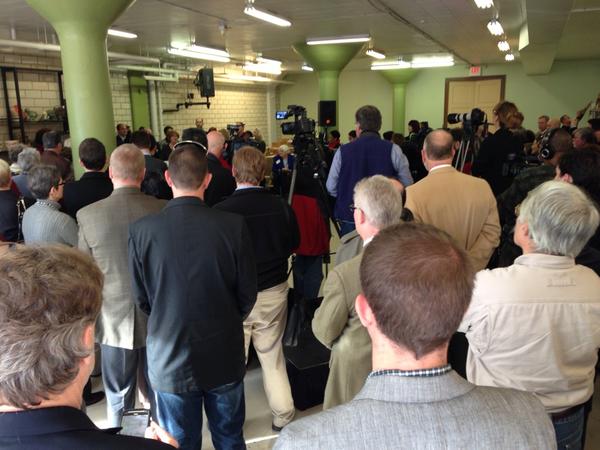Vice Mayor Roxanne Qualls (C) officially announced her 2013 mayoral campaign in Walnut Hills today before more than 100 people. The announcement comes a week after Councilman P.G. Sittenfeld (D) announced that he would not run for mayor next year. At this point, the election will pit Qualls against former Cincinnati City Councilman John Cranley (I), and a potential, but yet-to-be-determined Republican opponent.
Qualls’ announcement in Walnut Hills was both fitting as it one of the city’s neighborhoods for which she has been a major champion with regards to Complete Streets, form-based codes, and neighborhood investment. The location is also revealing in the fact that it hints at what kinds of policies would be promoted in her administration.

Roxanne Qualls mayoral campaign announcement by Twitter user @asesler.
“If the capital budget of the city doesn’t align with the comprehensive plan, then it doesn’t get implemented,” explained Vice Mayor Qualls on The UrbanCincy Podcast. “One of the key recommendations of the comprehensive plan is that it be implemented that the budget actually align with the recommendations of the comprehensive plan. That’s the job of elected officials, it’s my job, and those who are adopting this comp. plan that we start changing and investing in the areas that are recommended.”
While Qualls seems to be taking a more city-wide approach to her campaign, it appear that Cranley may take a more west side-focused approach due to his real estate investments in East Price Hill, which eventually forced him off of City Council in 2009 due to conflicts of interest.
Of course, Qualls had served as Cincinnati’s mayor once before (December 1993 – November 1999), but that term is not subjected to the current term limits that will force Mayor Mark Mallory (D) out of office next year. This perceived loophole exists due to a change in Cincinnati’s governance in 1999, which replaced the then indirectly elected mayor system with a “strong mayor” system. As a result, and should Qualls win, she would be eligible to serve two, four-year terms.
“A Qualls administration will be a great thing for Walnut Hills and all other neighborhoods,” Kathy Atkinson, board member and past president of the Walnut Hills Area Council, told UrbanCincy. “In the past several years, the strategic use of resources to advance key neighborhoods has served as a good revitalization approach. Building on that foundation, a Qualls administration will provide opportunities for each neighborhood to role up their sleeves and work alongside elected officials and city staff.”
Not everyone, however, is so thrilled with Qualls’ decision to run.
“Ms. Qualls is not the answer to lead Cincinnati,” exclaimed Hamilton County Republican Party Chairman, Alex Triantafilou, on his Facebook page. “Dodging tough budget decisions, building a streetcar, and pension mess all on her watch.”
With almost an entire year of campaigning ahead of us, one thing we know for sure is that this is only the beginning of what will most likely become a grueling campaign between two well-known political heavyweights.



